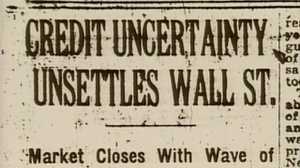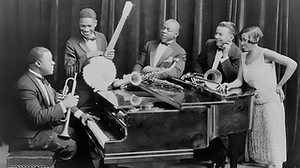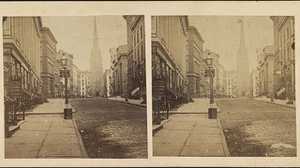Headlines
Stock market news moved from the financial pages to the front pages as the number of first-time investors grew in the 1920s. Throughout 1929 daily papers reported that the future looked bright for investors — even after the devastating market crash in October.

Read newspaper excerpts from three New York papers: The World, The New York Herald Tribune, and The New York Times.
Wave of Buying Sweeps Over Market as Stocks Swing Upward
Radio Flashes High; General Motors and Steels Soar
By Laurence Stern
The atmosphere of doubt and caution which Wall Street in recent weeks has come to regard almost as habitual on Thursdays was swept away yesterday in a rush of buying…
Perhaps the market’s own strength weighed as heavily with speculative minds as the logic of the situation, since the tape is the one institution Wall Street does not argue with. At any rate, the market appeared entirely confident from the opening gong. It was a firm, almost buoyant, opening, many initial transactions involving large blocks at sizable price advances…
The advance was one of the most vigorous of the year, amounting to a net gain of 6.97 points in the Dow Jones “average” of thirty representative industrial issues…
— The World, March 15, 1929
Stocks Soar As Bank Aid Ends Fear of Money Panic
By W. A. Lyon
The stock market strode out from under the shadow of a panic in call money that so lately threatened, revived in all its old strength yesterday. Assured that the New York banks were ready with their boundless resources to prevent a money crisis, the public and the professional trader set out to repair the damage done to prices on Monday and the major part of Tuesday.
Stocks in the aggregate, though bucking a 15 per cent rate for loans, enjoyed the greatest advance they have known in a single day in the last two years. Not even the surging bull markets of the memorable year 1928 saw such a day of heavy buying.
— New York Herald Tribune, March 28, 1929
Banker Says Boom Will Run Into 1930
That at least a part of the great amount of money in the securities market may represent temporary employment of funds eventually finding their way into business uses, and that the prosperity of the present business cycle will probably not end in 1929, is the belief expressed by the J. Henry Schroder Banking Corporation in the quarterly review of the London house of Schroder.
— The World, March 30, 1929
Brokers to Open Offices on Ships
The New York Stock Exchange decided yesterday to put to sea. It gave two brokerage houses permission to establish offices with continuous stock quotations by radio, on trans-Atlantic ships. Within a few weeks business will be following the flags of three nations across the bounding main.
The American business man will be able to take a vacation in Europe without stopping for a single day his transactions at the centre of speculation…
What the psychological effect may be remains to be seen. Lady Luck always has been a favorite companion for diversions seekers at sea, a fact that has provided good incomes to many generations of traveling card players. Ships’ pools and the “horse races” on deck always have been popular. They may retain their popularity, but now they will be outclassed.
— The World, October 4, 1929
Public Liquidation Spurred by Bears, Hits Low Market
Scare Orders From All Over Country Halt Ticker an Hour in Feverish Day
By Laurence Stern
With speculative nerves rubbed raw under the persistent hammering of bearish traders, a renewed wave of public liquidation swept over the stock market yesterday, depressing prices severely and hopelessly clogging the quotation ticker…
...To the majority of the market’s followers, who now must be counted in millions, the most significant aspect of the decline is that it has carried the average level of the list to a lower point than was reached on Oct. 4 in the sharp break that climaxed a month of gradual recession.
This raises a pertinent question, whether the bull movement of the last five years has definitely given way to a liquidating market…
— The World, October 20, 1929
Brokerage Houses Are Optimistic on the Recovery of Stocks
Brokers in Meeting Predict Recovery
A reassuring message to the stock market community went out last night over the country-wide network of private wires operated by brokerage houses. This was the result of a tacit agreement reached yesterday afternoon at a special meeting of the partners of about thirty-five of the largest wire houses of the New York Stock Exchange, at which the stock market situation was canvassed thoroughly…
...Much of the selling of the last few days, the brokers felt, was induced by hysteria. The views of all of the brokers present were heard, and none knew of anything disturbing to the general market situation…
— The New York Times, October 25, 1929
Brokers Believe Worst Is Over and Recommend Buying of Real Bargains
Wall Street in looking over the wreckage of the week, has come generally to the opinion that high grade investment issues can be bought now, without fear of a drastic decline. There is some difference of opinion as to whether not the correction must go further, but everyone realizes that the worst is over, and that there are bargains for those who are willing to buy conservatively and live through the immediate irregularity.
— New York Herald Tribune, October 27, 1929
Gigantic Bank Pool Pledged To Avert Disaster as Second Big Crash Stuns Wall Street
Largest Financial Powers in the City Meet After Day of Hysterical Liquidation Sinking Prices Below Thursday’s
By Laurence Stern
After the stock market had come crashing down again in a veritable deluge of forced and hysterical liquidation, word sped through the financial district last evening that the largest banks in the city were prepared to exert their organized power this morning to prevent further disaster.
Arrangements described as “fully adequate” were completed at a conference at the offices of J. P. Morgan & Co. at Broad and Wall Streets…
Although no formal statement was issued, it was the consensus of those at the meeting that the worst of the liquidation is over and that a natural demand for investment stocks now available on the bargain counter should go far toward an immediate restoration of trading stability.
— The World, October 29, 1929
Stocks Up in S trong Rally; Rockefellers Big Buyers; Exchanges Close 2-1/2 Days
By Ferdinand Lundberg
Revived by spontaneous investment buying and declarations of large extra cash dividends by leading companies, and free of the delirium that has recently gripped share owners, the stock market yesterday received a fresh start and scored a record comeback. Volume on the Stock Exchange totaled 10,727,320 shares, the third largest day on record.
The high spot of the day from a stock market viewpoint was the statement by John D. Rockefeller that there was no need to destroy values and that he and his son, John D. Rockefeller Jr., had been heavy buyers of stocks for investment in the last few days, and would continue to buy at present prices…
— New York Herald Tribune, October 31, 1929
Very Prosperous Year Is Forecast
Guenther Analyzes the Report of Mellon Covering 1929
That 1930 may be a very prosperous year, industrially and otherwise, without the peak conditions that made 1929 an exceptional year for business prosperity, is an observation made by Louis Guenther, publisher of the Financial World, in a statement based upon Secretary Mellon’s fiscal report…
“To grow too fast is often unhealthy because of the suddenness with which a readjustment must be met. By far and large the country would be better off were further progress made along more normal lines…
Fortunately, we have returned to a more normal mind in appraising prospects. We are not looking for the Midas touch on everything to which we turn. That makes us more satisfied with normal incomes and normal profit returns.”
— The World, December 15, 1929









